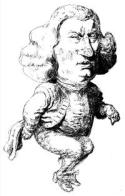JSA President John Wiltshire’s latest book, The Making of Dr Johnson, to be published during the Johnson Tercentenary next year, tells the story of how Samuel Johnson became known as “Dr Johnson”, a quickly recognisable figure, famous for “talking for victory”. It is one of a series called “Icons of Modern Culture” published by Helm Information.
Several members of the Society, including the Western Idler and Dr Paul Tankard, have helped to make the book an important record of the history of the great man.
Like all such Icons, “Dr Johnson” is a kind of fiction. Johnson began as “the Caliban of literature”, a figure whose personal “deformities” were matched by his intolerable behaviour, but over the course of the next two centuries he was transformed.
He became not only a patriotic British mascot, the great conversationalist, but a revered and majestic figure, whose battles with personal difficulties, charity and kindnesses, made him a veritable saint – “the Saint of Fleet Street”, as Virginia Woolf called him.
Boswell’s great Life of Samuel Johnson of course is treated fully in the book, but one of its main aims is to show that there were many Johnsons. The memoirs by Mrs Piozzi, the Life by Sir John Hawkins as well as the diaries of Fanny Burney, reveal sides of Johnson that Boswell preferred not to dwell on, and are quoted extensively. Other aspects of Johnson are revealed in the famous series of pictures of him by his friend Sir Joshua Reynolds, the subject of a central chapter of the book by Daniel Vuillermin.
Boswell’s Johnson was instrumental in creating “Dr Johnson”, a figure whose reported talk triumphed over his own writings. Boswell’s creation dominated the Victorian age, gaining wider currency when scenes from Johnson’s life were the subject of narrative paintings and widely distributed as engravings, even appearing on pottery and souvenir items.
Much later, Johnson became “pathologised”, the topic of medical articles diagnosing him with all sorts of mental and physical conditions. These aspects of Johnson’s history are presented through copious extracts from many sources.
The Making of Dr Johnson is very fully illustrated, and includes rare images of Johnson and Johnsoniana, including all of Reynolds’s portraits, as well as pictures of statues and monuments.

